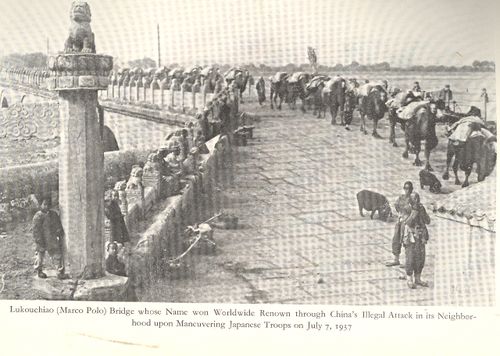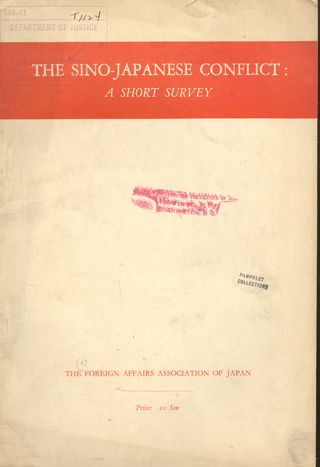JF Ptak Science Books LLC Post 611
The creation of international incidents to bring/drag countries into open war against one another is quite ancient--just in our own recent times we have seen the Tonkin Gulf "Incident" and the Iraqi WMD scenarios play out to long and disasterous (and continuing) results. And so too with the so-called beginning of the Sino-Japanese War of 1937-1945. There is a little trouble with the beginning date of this war--1937--since the Japanese had already invaded and militarily punished China beginning in 1931. But no matter to the author of The Sino-Japanese Conflict, a Short Survey (published in English in Japan in October 1937). The unnamed
correspondent centered his attention on what the Japanese contended was open rebellion and hostility to Japan, which was supposed to be the attack by Chinese army elements upon garrisoned Japanese troops at the Lugou Qiao ("Marco Polo") Bridge in the suburbs of Beijing in June/July 1937. He doesn't mention why the Japanese troops were there, but so it goes.
What happened before the Bridge Incident was this: the Japanese attacked and occupied Manchuria in 1931, establishing a puppet government there in the form of Manchuko Province. In 1932 the Japanese armed forces invaded Chahar Province, and in 1933 Rehe--this meant that all of China north of the Great Wall was in Japan's steely hands. The Japanese forces were exceptionally well-equipped, their air force finding virtually no resistance and its tanks finding no response from anti-tank weapons. There was a fair amount of use of sabres by Chinese troops. (Reminds me somewhat of the Nazi/Poland fight in September 1939.)
So, quickly told, what happened at the bridge was that a Japanese soldier went missing, and the Japanese forces responded in full force. Weeks later, the fighting was all over, the Chinese sent into retreat, and Japan was in control of Beijing and just about everything else north, west and east. The missing soldier eventually showed up This wasn't on the level of Tonkin or WMD, as the Japanese were already entrenched in China for years; but the so-called "incident" at the bridge marks (for most) the real beginning of the Sino-Japanese War. At least that's when the armies made no pretense about not-fighting. Millions of Chinese lives later, the Japanese were defeated.
The challenge to the writer of this pamphlet was to deal with the affront of China to the Japanese forces in their country without mentioning that Japan was an invading force. Happens all the time.
The photo of the bridge is benign, showing workers, kids at play, a roaming pig; symbols of peace on the 400-year-old structure. The scene was painted to make it appear that the Chinese showed up, manouevered around the "garrisoned" Japanese troops, and attacked. 
The bombing (and "Rape") of Nanjng was also, incredibly, the fault of the Chinese. "The conduct of Japanese planes calls for no reproach" we read. This was the beginning of a major atrocity, with 300,000 Chinese in Nanjing murdered by the spring of 1938.
The pamphlet ends on the note that the hostilities and fighting were firmly in the hands of the Chinese. "Protracted hostilities is much more China's problem than Japan's" it reads, and then, somehow, explaining it all in terms of the Japanese government being more capable of funding a war and, therefore, should. This pamphlet was supposed to make the Japanese invasion and decimation of China as invisible to the consciousness of the West as possible--it was being done in a series of handy hearts-and-minds engines like this one, the hope being that the conflict would be viewed as an internal affair, and that Japan would be left alone, and that China "had it coming" anyway. Pretty convincing stuff if you didn't think about it too hard, or, well, if you didn't think about it at all. But, as we've seen again just recently, if you repeat a falsehood often enough, it becomes part of the cognitive landscape, a misty fog of possibilitiy; which means it might as well be true.




Comments